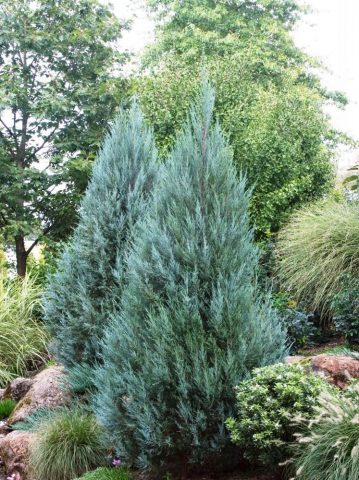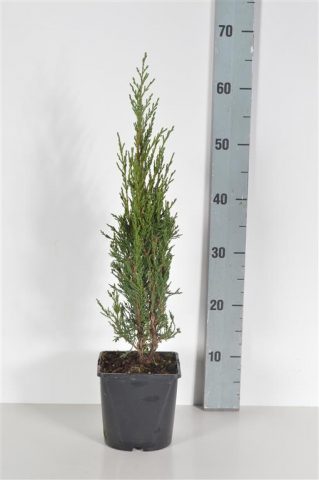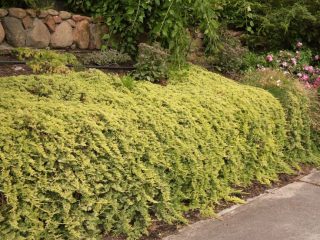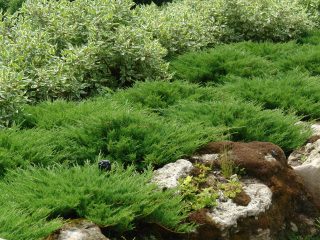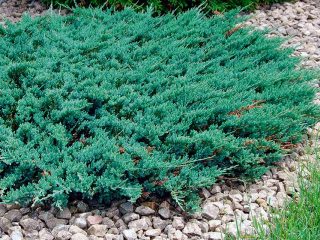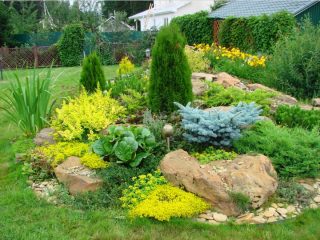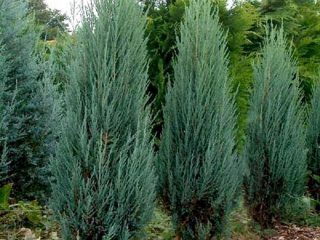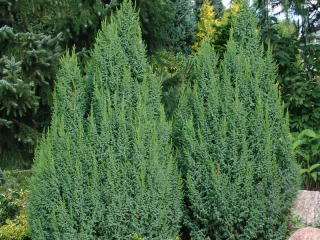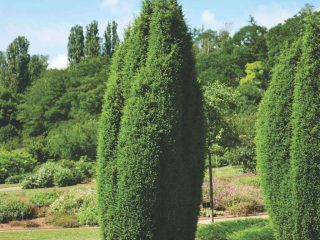Content
Juniper rock Moonglow is one of the most beautiful evergreen shrubs, which can not only improve the land. The seedling has medicinal properties. Its peculiarity is its high growth, pyramidal shape and original needles, which in appearance resemble scales tightly adjacent to each other. In nature, it is found on rocky soils or on mountain slopes located at an altitude of 2700 m above sea level.
Description of juniper rocky Moonglow
If we consider the description and photo of the Moonglow rock juniper, it should be noted that this variety is capable of stretching up to 18 m in height and reaching a girth of 2 m. In urban conditions, Moonglow is much thinner and lower. The formation of the crown of the rocky Moonglow begins from the very base. The shape is conical, in the process of growth and development it begins to round off. Young shoots, as a rule, have a light blue or bluish-green tint.
Juniper leaves are opposite, resemble scales tightly adjacent to each other, and can be ovoid or rhombic in shape. Leaves can be of several colors:
- blue-gray;
- dark green;
- bluish-green.
The needle-shaped needles reach a width of 2 mm and a length of 12 mm. After abundant flowering, fruits appear in the form of dark blue balls. The cones that appear contain seeds up to 0.5 cm in diameter, red-brown in color.
Juniper Moonglow in landscape design
According to the description, Moonglow juniper has an attractive appearance, as a result of which it is increasingly used in the design of land plots. Moonglow appears not only in single, but also in group plantings, in heather or rocky gardens. With the help of juniper you can renew the alley, decorate the summer garden, and use it as a central composition together with flower bushes.
The crown of the Moonglow rock juniper is clear, from a geometric point of view, correct. Often, juniper is used as a background and other types of plants are planted in front of it, creating entire compositions.
Planting and caring for Moonglow juniper
Moonglow juniper is easy to care for and resistant to urban environments. It is important to understand that Rock Moonglow tolerates drought well, but cannot fully grow if the soil is waterlogged.
In case of prolonged drought, watering can be done, but no more than 3 times during the season. It is recommended to water young bushes with warm water in the evening.
The level of frost resistance depends entirely on the selected variety.
Preparing seedlings and planting area
Rock juniper Moonglow (juniperus scopulorum Moonglow) is planted in open ground in the spring and seedlings that are 3–4 years old are used for this. The juniper must be completely healthy, without damage or visible defects. Before planting in open ground, it is necessary to place the roots in water for a while, remove damaged parts of the root system and then add a growth stimulator.
Soil preparation begins 1–2 weeks before the planned planting. To do this you need:
- Dig holes for each bush. They should be several times larger than the root system.
- Place a drainage layer of broken bricks and sand on the bottom.
- Fill the hole 2/3 with nutrient soil.
After the place has been prepared, you can plant rocky juniper Moonglow.
Landing rules
As a rule, juniper is planted in open ground in early spring. The place should be sunny. The occurrence of groundwater plays a huge role. The ground should not be waterlogged, therefore, the water should run deep. Tall varieties are recommended to be planted on fertile soils; in other cases, it is better to give preference to small-sized Moonglow juniper - dwarf varieties.
In the process of planting planting material, adhere to the following recommendations:
- the hole is made several times larger than the root system;
- the distance between dwarf varieties is 0.5 m, between large ones – 2 m;
- a drainage layer is laid at the bottom of each pit using crushed stone or broken building bricks;
- the seedlings are covered with a fertile mixture of sand, peat and turf.
After the Moonglow rock juniper is planted, it is watered abundantly and the soil around is mulched.
Watering and fertilizing
In order for the Moonglow rock juniper to grow and develop well, it is necessary to provide high-quality care, which includes not only the preparation of planting material and the correct choice of location, but also watering and fertilizing.
It is recommended to water an adult juniper no more than 3 times during the season. Moonglow grows well in drought, but can die if the soil is too waterlogged.
Only young bushes need feeding. As a rule, fertilizers must be applied at the end of April or at the beginning of May. The following drugs can be used for these purposes:
- "Kemara-universal";
- "Nitroammophoska".
Mulching and loosening
Juniper rock Moonglow will delight with its attractive appearance only if it is given due attention and provided with high-quality care. During the growth process, it is necessary to promptly remove weeds, which can not only slow down growth, but also remove all nutrients from the soil.In order for the root system to receive the required amount of oxygen, the soil should be loosened. After each watering, the soil is mulched, as a result of which the moisture does not evaporate so quickly.
Trimming and shaping
As a rule, Rocky Moonglow juniper does not require any measures to form and trim the crown. This is due to the fact that juniper is naturally awarded with a regular and effective crown. Despite this, sanitary pruning is necessary.
It is necessary not only to prune the bush correctly, but also to choose the right time for this. In most cases, sanitary pruning is carried out in early spring, before the movement of juices begins. It is recommended to choose a rainy or cloudy day to carry out the work.
The first step is to remove all dry, damaged and diseased branches. It is also worth removing those that grow incorrectly and spoil the entire appearance. If necessary, you can independently control the height and diameter of the Moonglow rock juniper. It is important to consider that when leveling the contours of the crown, you cannot shorten the branches by more than 20 mm.
Preparing for winter
This variety of juniper has a high level of frost resistance, but despite this, in early spring, when the soil has not yet thawed and the sun begins to shine brightly, there is a chance that the needles will get burned. To avoid this, you need to take care of Moonglow cover in advance.
This procedure can be carried out at the end of January or the end of February, but some gardeners prefer to do this before the onset of frost. It is recommended to use spruce branches. The cover is removed after the soil has completely thawed.If there is a large amount of snow on the branches in winter, they may break under its weight. In late autumn, it is recommended to tie the branches together using hemp twine or strips of burlap for this purpose.
Reproduction of rock juniper Moonglow
Considering the reviews about rock juniper Moonglow, it is worth noting that propagation is carried out in several ways:
- layering;
- cuttings.
In the first case, you can only get the creeping form of this variety. Required:
- Remove needles from the stem.
- Fix the shoot on the soil surface.
Rooting will occur after 6–12 months. After the cuttings have taken root, they must be cut off from the mother juniper and transplanted to a permanent place of growth.
If you plan to propagate Moonglow by cuttings, then planting material should be prepared in the spring. In this case, semi-lignified shoots are selected along with the heel. Rooting of cuttings is done in greenhouses.
Diseases and pests
As practice shows, rock juniper is susceptible to fungal diseases, as a result of which it loses its attractive appearance, the branches gradually dry out and Moonglow dies. In the early stages of detection of fungus, it is recommended to immediately treat the juniper with a fungicide.
Drying of branches is a serious disease. In this case, you will need to remove all branches that have yellow needles and treat them with a fungicide. If the lesion is severe, the Moonglow rock juniper is completely dug up and burned along with the root system.
Conclusion
Rock juniper Moonglow, thanks to its attractive appearance, is loved by designers. It is often used when registering land plots. Since Moonglow is unpretentious in care, its cultivation can be done not only by experienced, but also by novice gardeners.
